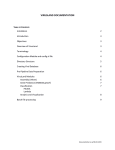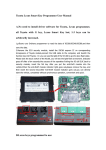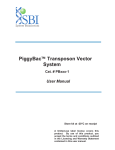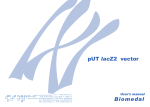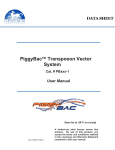Download PingPongPro v1.0
Transcript
PingPongPro v1.0 - User Manual Sebastian Uhrig ([email protected]) September 27, 2014 Table of contents 1. What’s new? ....................................................................................... 2 2. Introduction ....................................................................................... 2 3. Quick start ......................................................................................... 2 4. How PingPongPro works ........................................................................ 3 4.1. 4.2. 5. 5.1. 5.2. 5.3. Detecting ping-pong signatures ...............................................................3 Finding transposable elements with ping-pong cycle activity ............................4 Installation ......................................................................................... 5 Using pre-compiled executables ..............................................................5 Compiling from source .........................................................................5 Additional pre-requisites for plotting ........................................................6 6. Command-line options ........................................................................... 7 7. Accepted input formats ......................................................................... 9 7.1. 7.2. 8. 8.1. 8.2. 8.3. 8.4. 9. High-throughput sequencing data ............................................................9 Annotations of transposable elements .......................................................9 Output ............................................................................................. 11 Ping-pong signatures.......................................................................... 11 Ping-pong cycle activity per transposon ................................................... 11 Browser tracks ................................................................................. 13 Plots............................................................................................. 14 References ........................................................................................ 15 PingPongPro v1.0 - User Manual 1 1. What’s new? v1.0: This is the initial release of PingPongPro. 2. Introduction Piwi-interacting RNAs (piRNAs) are a class of small non-coding RNAs, predominantly active in the germ line. There, they limit the detrimental effect of transposons on the genome. They do so by forming a complex with Piwi proteins. The complex binds and then cleaves mRNA molecules of active transposons. The resulting mRNA fragments induce the production of more piRNAs, thus reinforcing the anti-transposon response in a feed-forward loop called the "ping-pong cycle" [2][3]. A key question in ping-pong cycle research is identification of piRNAs which are amplified through the cycle. PingPongPro is a command-line tool for detecting ping-pong cycle activity in piRNA-Seq data. 3. Quick start Pre-compiled binaries of PingPongPro can be downloaded from here: http://sourceforge.net/projects/pingpongpro/files/ PingPongPro takes a file with aligned reads in SAM or BAM format as input (see http://samtools.sourceforge.net/ for more information). This file is passed to PingPongPro using the parameter -i. For example: pingpongpro -i alignments.bam The program then writes a list of putative ping-pong signatures to the file pingpong_signatures.tsv. The column FDR in this file indicates how confident PingPongPro is that a given ping-pong signature is not just a random alignment of reads, but truly a product of ping-pong cycle activity. FDRs close to 0 are good and FDRs close to 1 are bad. In addition, PingPongPro can find transposable elements that are suppressed through the ping-pong cycle, when run with the parameter -T: pingpongpro -i alignments.bam -T 1000 PingPongPro produces a file named predicted_transposons.tsv, which contains a list of regions, which are possibly suppressed by the ping-pong cycle. The column qValue indicates PingPongPro's confidence. Again, values close to 0 (ideally < 0.01) are good and values close to 1 are bad. The argument 1000 tells PingPongPro to merge ping-pong signatures within a window of 1000 bp into one region. PingPongPro can check a list of transposable elements of interest for ping-pong cycle activity. The list must take the form of an annotation file in GFF, GTF or BED file format (see http://genome.ucsc.edu/FAQ/FAQformat.html for more information). It is passed to PingPongPro using the -t parameter: pingpongpro -i alignments.bam -t annotated_transposons.bed PingPongPro v1.0 - User Manual 2 PingPongPro then generates a file named transposons.tsv, which assigns a q-value to every transposon given in the file annotated_transposons.bed. The file is to be interpreted alike the file predicted_transposons.tsv. Lastly, PingPongPro can generate browser track files. These files can be loaded into the UCSC Genome Browser (http://genome.ucsc.edu/), IGV (https://www.broadinstitute.org/ igv/home) or other genome browsers, for visualization of ping-pong signatures and pingpong regions. PingPongPro must be launched with the switch -b, if browser tracks should be generated. For example: pingpongpro -i alignments.bam -T 1000 -b 4. How PingPongPro works 4.1. Detecting ping-pong signatures The ping-pong cycle produces short RNA molecules which are complementary at their 5’ ends over a length of exactly ten nucleotides. In piRNA-Seq data, these molecules appear as stacks of reads on opposite strands, which overlap by ten nucleotides [5][7]. Figure 1: Two examples of ping-pong signatures. The figure on the left shows the coverage around the genomic coordinate chr2L:2,295,900 (which is inside the transposon copia) of a piRNA-Seq dataset from D. melanogaster (available at the NCBI Sequence Read Archive [10] via the SRA accession number SRR499784 [7]). There are three stacks of reads on the forward strand and two stacks on the reverse strand which stick out. Four of them have been highlighted, because they are likely to result from ping-pong cycle activity. Reads thought to belong to these stacks are colored red on the forward strand and blue on the reverse strand. The stacks satisfy all the characteristics of a typical ping-pong signature: They are all aligned at their 5’ ends and the stacks on the forward strand overlap with the stacks on the reverse strand by ten nucleotides. The characteristic overlap is marked by dashed lines. The left-most stack on the forward strand (not highlighted) is probably not to be attributed to the ping-pong cycle, because there is no stack on the reverse strand overlapping it by ten nucleotides. PingPongPro scans a piRNA-Seq dataset for this pattern (also known as “ping-pong signatures”). Ping-pong signatures are not always as evident as in Figure 1. When the stacks are not that prominent, they are hard to distinguish from random alignments of reads, which only happen to overlap by ten nucleotides by chance. PingPongPro therefore evaluates a total of three properties that are characteristic for true ping-pong signatures: PingPongPro v1.0 - User Manual 3 Stack height: High stacks of reads are the most reliable indicator of a true pingpong signature. Independence of the local coverage: High stacks are not necessarily the result of ping-pong cycle activity. In regions with good coverage, the probability is increased that reads stack up on each other. Conversely, a relatively small stack likely is to be attributed to the ping-pong cycle, when there are hardly any other reads in the vicinity. In conclusion, stacks that are considerably higher than what can be explained by the local coverage (i.e., independent of the local coverage) are indicators of true ping-pong signatures. Adenine bias: piRNAs naturally have a preference for uracil at their 5’ ends. Since piRNAs amplified through the ping-pong cycle are complementary over a length of ten nucleotides, these piRNAs also show a preference for adenine at position ten. Consequently, stacks of reads with adenine at position ten are a third indicator of true ping-pong signatures. PingPongPro examines the properties of every putative ping-pong signature. In order to decide, if this combination of properties is peculiar to ping-pong signatures, it counts how many stacks there are in the dataset which have the same combination of properties, but which overlap by some other length than ten nucleotides. If there are many, then PingPongPro concludes that this combination of properties is easily satisfied by random alignments of reads and not something which is peculiar to ping-pong signatures. In this case, the signature gets a bad score. If, on the other hand, the signature has properties which are rarely seen in combination with arbitrary overlaps, then the signature gets a good score. The score is directly based on relative frequencies. For example, if PingPongPro finds 100 stacks with an overlap of ten nucleotides and 18 stacks with the same combination of properties, but with different overlaps, then it estimates that about 18 % of the putative ping-pong stacks must be due to chance. It cannot tell which of the putative ping-pong stacks are the product of ping-pong cycle activity and which are due to chance. Therefore, all of them are assigned a score of 0.82 (100 % minus 18 %). As a result, only 82 % of the reads of these signatures will be counted and the rest is discarded. Ultimately, this weighting of signatures ensures that only those reads are counted which are probably not to be attributed to coincidence. 4.2. Finding transposable elements with ping-pong cycle activity In order to decide if a given transposon is suppressed by the ping-pong cycle, PingPongPro counts the number of reads that are part of putative ping-pong signatures within the region of the transposon. The reads are weighted before counting, as explained in the previous section. PingPongPro then counts how many reads are part of stacks which overlap by some other length than ten nucleotides. Again, reads are weighted before counting. If the transposon is ping-pong-regulated, then the abundance of reads which are part of putative ping-pong signatures should be considerably higher than the abundance of reads which are part of arbitrarily overlapping stacks. The difference in abundance is normalized to a z-score, which, in turn, is converted to a p-value. The lower the p-value, the more confident PingPongPro is that the transposon shows signs of ping-pong cycle activity. PingPongPro v1.0 - User Manual 4 5. Installation 5.1. Using pre-compiled executables Pre-compiled executables of PingPongPro do not require any installation. They only need to be downloaded and extracted from a compressed archive. Linux 32-bit and 64-bit binary distributions of PingPongPro are available for Linux at: http://sourceforge.net/projects/pingpongpro/files/ After downloading the respective .tar.gz-file for your architecture, extract it with tar: tar –xvzf pingpongpro-*-linux*.tar.gz Windows 32-bit and 64-bit binary distributions of PingPongPro are available for Windows at: http://sourceforge.net/projects/pingpongpro/files/ After downloading the respective .zip-file for your architecture, extract it by rightclicking the .zip-file and choosing Extract all … from the context menu. 5.2. Compiling from source PingPongPro builds on the SeqAn library (http://www.seqan.de/). You first need to download the SeqAn API, before you can compile PingPongPro from source. Linux Follow the instructions for installing the SeqAn API on Linux: http://trac.seqan.de/wiki/Tutorial/GettingStarted/LinuxMakefiles Skip the Hello World! example. Instead, create a sandbox for PingPongPro: cd seqan-trunk ./util/bin/skel.py repository sandbox/workspace ./util/bin/skel.py app pingpongpro sandbox/workspace Download the source code of PingPongPro from: http://sourceforge.net/projects/pingpongpro/files/ Extract it to seqan-trunk/sandbox/workspace: tar –xvzf pingpongpro-*-source.tar.gz mv pingpongpro-*-source/* sandbox/workspace/apps/pingpongpro/ Compile PingPongPro: cd ../seqan-trunk-build/debug cmake . make pingpongpro PingPongPro v1.0 - User Manual 5 The compiled executable can then be found in seqan-trunk-build/debug/bin/. Windows Download the contribution package for SeqAn on Windows as explained here: http://trac.seqan.de/wiki/HowTo/InstallContribsWindows Follow the instructions for installing the SeqAn API on Windows: http://trac.seqan.de/wiki/Tutorial/GettingStarted/WindowsVisualStudio Skip the Hello World! example. Instead, create a sandbox for PingPongPro: cd seqan-trunk python util\bin\skel.py repository sandbox\workspace python util\bin\skel.py app pingpongpro sandbox\workspace Download the source code of PingPongPro from: http://sourceforge.net/projects/pingpongpro/files/ Extract it to seqan-trunk\sandbox\workspace with a program that is capable of extracting files from .tar.gz-archives. Then move all the files to the newly created sandbox: move pingpongpro-*-source\* sandbox\workspace\apps\pingpongpro\ Rerun cmake to register the newly created application: cd ..\seqan-trunk-build\vs9 cmake . Open the Visual Studio solution: seqan-trunk-build\release\sandbox\workspace\apps\pingpongpro\ seqan_sandbox_workspace_apps_pingpongpro.sln In Visual Studio, go to Build Build Solution (F7). The compiled executable can then be found in seqan-trunk-build\debug\bin\Debug\. 5.3. Additional pre-requisites for plotting PingPongPro uses R-Project (http://www.r-project.org/) [8] to generate plots. If you want PingPongPro to generate plots (option –p), then install R-Project. Linux Instructions on how to install R-Project on Linux can be found here: http://cran.r-project.org/doc/manuals/r-release/R-admin.html#Installing-R-underUnix_002dalikes Make sure Rscript is in your PATH environment variable, before running PingPongPro: export PATH=/path/to/R_HOME/bin:$PATH Windows Instructions on how to install R-Project on Windows can be found here: PingPongPro v1.0 - User Manual 6 http://cran.r-project.org/doc/manuals/r-release/R-admin.html#Installing-R-underWindows Make sure Rscript is in your PATH environment variable, before running PingPongPro: set PATH=C:\path\to\R_HOME\bin;%PATH% 6. Command-line options -h, --help Print a short help about available command-line options and exit. Default: off --version Print information about the version of PingPongPro and exit. Default: off -b, --browserTracks By default, PingPongPro produces output in TSV format, only. When –b is specified, it creates additional browser track files, which are suitable for display in common genome browsers, such as the UCSC Genome Browser (http://genome.ucsc.edu/) [4] or the Integrative Genomics Viewer (https://www.broadinstitute.org/igv/home) [9]. See section 8.3 for more information on the types of tracks that are generated. Default: off -s, --min-stack-height NUMBER_OF_READS Ping-pong signatures with one or both stacks smaller than NUMBER_OF_READS are omitted from the output. They are still considered to find suppressed transposons, however. Default: 0 -i, --input PATH Specify the path to a file with high-throughput sequencing data that PingPongPro shall scan for signs of ping-pong cycle activity. See section 7.1 for accepted file types. On Linux, you can use the special file /dev/stdin to make PingPongPro read data from standard input. Specifying this option is mandatory. Default: none PingPongPro v1.0 - User Manual 7 -l, --min-alignment-length LENGTH -L, --max-alignment-length LENGTH PingPongPro ignores alignments given in the input file that are shorter or longer than the typical length of a piRNA (between 24 and 32 nucleotides). Use the parameter –l to define the minimum length and the parameter –L to define the maximum length of alignments that should not be ignored by PingPongPro. Default: 24 for –l and 32 for –L -m, --multi-hits METHOD Very often, reads of piRNAs map to several loci, because the genome contains multiple copies of a transposable element that is targeted by a particular piRNA. Usually, such multi-mapping reads (“multi-hits”) are ignored during analysis of RNASeq data, because it is unclear where the read really originated from. In piRNA-Seq data however, it would lead to a major fraction of the reads being lost, if multi-hits were ignored. PingPongPro can handle multi-hits in one of several ways: weighted: A multi-hit is counted as the reciprocal of the number of alignments of the same read. For example, if a read has 5 alignments, it is counted as one fifth. unique: No distinction is made between multi-hits and unique hits. Multi-hits are counted as one full read. This option is useful, if the input data has already been filtered for multi-hits, such that all but one randomly selected multi-hit have been deleted from the input file. discard: Multi-hits are not counted at all. This option can be used to compare the effect of multi-hits on the output of PingPongPro. Default: weighted -o, --output PATH Specify the path to a directory, where PingPongPro should put all output files. The directory is created, if it does not exist yet. The parent directory must exist, though. Existing files are overwritten without warning. If this option is omitted, then PingPongPro writes all files to the current working directory. It is therefore recommended to run PingPongPro from an empty directory, if this option is not specified. Default: current working directory -p, --plot This option instructs PingPongPro to generate plots. Refer to section 8.4 for information about the types of plots, which are generated. PingPongPro uses R-Project for rendering of plots. Make sure the program Rscript is available in the PATH environment variable (see section 5.3). Default: off PingPongPro v1.0 - User Manual 8 -t, --transposons PATH PingPongPro can check a given list of transposons for ping-pong cycle activity. If PATH points to a file with coordinates of transposons, then PingPongPro will produce statistics about ping-pong cycle activity within the regions of the given transposons. See section 7.2 for file formats that are accepted as input. Section 8.2 describes the output that is produced. This option can be specified multiple times. All given files will be processed, but only one output file is produced, in which the transposons of all input files are merged. Default: none -T, --predict-transposons RANGE If a list of annotated transposons is not available, then PingPongPro can predict the regions of transposons (or more generally speaking, regions with ping-pong cycle activity). It does so by defining regions around ping-pong signatures dynamically. Ping-pong signatures that are not more than RANGE base pairs apart from each other will be merged into a contiguous region. Regions with less than two ping-pong signatures or a shorter length than 30 base pairs are not reported. Default: 1000 -v, --verbose When this option is given, then PingPongPro reports its current progress and the time it took to run each step to standard error. Default: off 7. Accepted input formats 7.1. High-throughput sequencing data PingPongPro scans high-throughput sequencing data given via the parameter -i for signs of ping-pong cycle activity. Accepted file types for the high-throughput sequencing data are the Sequence Alignment/Map (SAM) format and the Binary-Compressed Sequence Alignment/Map (BAM) format. See http://samtools.sourceforge.net/ for more information on these file formats. Only single-end alignments can be processed by PingPongPro. Pairedend alignments are treated like single-end alignments. The SAM / BAM input file does not need to be sorted or indexed. 7.2. Annotations of transposable elements PingPongPro can check a list of transposable elements given in parameter –t for ping-pong cycle activity. It accepts various formats. The format is determined by the file extension. In general, only text files are accepted. Every line represents the coordinates of a single copy of a transposon. Lines that cannot be parsed are discarded silently. The chromosome names in the annotation file must be identical to those in the file with high-throughput sequencing data. PingPongPro v1.0 - User Manual 9 BED file format (file extension .bed) Refer to http://genome.ucsc.edu/FAQ/FAQformat.html#format1 for information about the BED file format. PingPongPro only uses the fields chrom (1), chromStart (2), chromEnd (3), name (4) and strand (6). All other columns are ignored. The fourth field (name) serves as the identifier of a transposon. Comma-separated values (file extension .csv) .csv-files are expected to have at least five fields. The fields must be separated by exactly one comma. Fields can optionally be enclosed by double-quotes. The following table lists the fields and their meanings. All other columns are ignored. Table 1: Fields in .csv-formatted transposon annotations # Field name Description 1 identifier A name that uniquely identifies the transposon 2 strand The strand which the transposon is located on (either + or –) 3 chromosome The chromosome which the transposon is located on 4 start Start coordinate of the transposon (zero-based) 5 end End coordinate of the transposon (half-open, i.e., the coordinate points to the first base pair after the end of the transposon) Example: FBti0015567,-,chr2L,20740303,20748120 General Feature Format (file extension .gff) Refer to http://genome.ucsc.edu/FAQ/FAQformat.html#format3 for information about the General Feature Format. PingPongPro only uses the fields seqname (1), start (4), end (5), strand (7) and group (9). All other columns are ignored. Notably, the field feature (3) is not evaluated, such that all lines in the file are checked for ping-pong cycle activity, regardless of their feature type. The ninth field (group) serves as the identifier of a transposon. Gene Transfer Format (file extension .gtf) Refer to http://genome.ucsc.edu/FAQ/FAQformat.html#format4 for information about the Gene Transfer Format. PingPongPro parses .gtf-files in the exact same way as files of the General Feature Format. Tab-separated values (file extension .tsv) PingPongPro parses .tsv-files in the exact same way as .csv-files, with two exceptions: Fields must be separated by exactly one tab. And fields cannot optionally be enclosed in double-quotes. Example: FBti0015567 - chr2L PingPongPro v1.0 - User Manual 20740303 20748120 10 8. Output 8.1. Ping-pong signatures PingPongPro outputs the list of all stacks which overlap by ten nucleotides in a tabseparated file named ping-pong_signatures.tsv. The following table lists the meanings of the columns in the file: Table 2: Output of ping-pong signatures in .tsv-format # Field name Description 1 contig The chromosome or scaffold which the ping-pong signature is located on. 2 position The coordinate of the 5’ end of the stack on the forward strand (zero-based). 3 FDR Estimated fraction of signatures that have the same combination of properties, but that are not true ping-pong signatures. Lower values indicate higher confidence that the signature is not due to coincidence. For example, if there are 100 putative ping-pong signatures and 18 stacks with the same combination of properties, but with a different overlap, then FDR has a value of approximately 0.18 (18 divided by 100). 4 stackHeightOnPlusStrand The number of reads that make up the stack on the forward strand (may be fractional, if it contains multi-hits). 5 stackHeightOnMinusStrand The number of reads that make up the stack on the reverse strand (may be fractional, if it contains multi-hits). 8.2. Ping-pong cycle activity per transposon If the parameter –t or –T is specified, PingPongPro produces statistics about ping-pong cycle activity within the regions of given (-t) or predicted (-T) transposons. Statistics about given transposons are written to a tab-separated file named transposons.tsv; statistics about predicted transposons are written to a tab-separated file named predicted_transposons.tsv. Both files have the same format: Table 3: Output of ping-pong cycle activity per transposon in .tsv-format # 1 Field name Description identifier For annotated transposons, the identifier of the transposon given in the annotation file; for predicted transposons, a dynamically generated identifier based on coordinates. PingPongPro v1.0 - User Manual 11 # Field name Description 2 strand The strand which the transposon is located on (either + or –). In the file for predicted transposons, this field always has the value +. This is because PingPongPro currently does not try to guess the strand. 3 contig The chromosome or scaffold which the transposon is located on. 4 start Start coordinate of the transposon (zero-based). 5 end End coordinate of the transposon (half-open, i.e., the coordinate points to the first base pair after the end of the transposon). 6 pValue P-value indicating the confidence that there is ping-pong cycle activity within the region of the transposon. 7 qValue P-value corrected for multiple testing using the false discovery rate procedure by Benjamini and Hochberg, 1995. pingPongReads The number of reads that overlap by ten nucleotides within the region of the transposon (after the reads have been weighted by PingPongPro’s scoring system). normalizedPingPongReads RPKM-normalized value of pingPongReads, i.e., the value of pingPongReads divided by the length of the transposon in kbp and divided by the total number of reads in the input file per million. This figure should be suitable to compare the ping-pong cycle activity between transposons and between samples. 10 discardedPingPongReads The number of reads which overlap by ten nucleotides within the region of the transposon but which have been discarded by PingPongPro’s scoring system. The sum of pingPongReads and discarded PingPongReads equals the unweighted number of reads which overlap by ten nucleotides within the region of the transposon. 11 strandRatio The unweighted number of ping-pong reads on the forward strand divided by the unweighted number of ping-pong reads on the reverse strand. 8 9 PingPongPro v1.0 - User Manual 12 8.3. Browser tracks When PingPongPro is run with the parameter –b, it creates browser track files, which are suitable for display in common genome browsers, such as the UCSC Genome Browser (http://genome.ucsc.edu/) or the Integrative Genomics Viewer (https://www.broadinstitute.org/igv/home). Figure 2: Visualization of ping-pong signatures in the UCSC Genome Browser. PingPongPro is able to generate output in formats suitable for visualization in genome browsers like the UCSC Genome Browser and IGV. This figure is a screenshot of the UCSC Genome Browser. It depicts ping-pong signatures within the transposable element FBti0019102 with the genomic coordinate chr2L:1220184-1227592 in D. melanogaster (available at the NCBI Sequence Read Archive via the SRA accession number SRR010960 [5]). The topmost row (read stacks on - strand) shows the heights of stacks on the reverse strand; the second row (read stacks on + strand) shows the heights of stacks on the forward strand. Most of the stacks have fractional heights, because they are mostly made up of multi-mapping reads. The third row (scores) shows the scores that PongPongPro calculated for the ping-pong signatures. The heights of the bars range between 0 and 1 and represent the scores of ping-pong signatures. The fourth row (Flybase transposons) shows the location of annotated transposons. Transposons are shaded according to their score: Transposons with high scores are darker and transposons with low scores are brighter. The last row (RepeatMasker) shows regions with repetitive elements. The transposon is covered with ping-pong signatures from start to end, which is an indication that it is thoroughly suppressed through the ping-pong cycle. Ping-pong signatures Three .bedGraph-files are generated for the detected ping-pong signatures. Refer to http://genome.ucsc.edu/FAQ/FAQformat.html#format1.8 for more information about the bedGraph file format. The file ping-pong_signatures_read_stacks_on_minus_strand.bedGraph contains the heights of the stacks on the reverse strand of ping-pong signatures. The file ping-pong_signatures_read_stacks_on_plus_strand.bedGraph contains the heights of the stacks on the forward strand of ping-pong signatures. The file pingPingPongPro v1.0 - User Manual 13 pong_signatures_scores.bedGraph contains the scores of ping-pong signatures. The scores are calculated as 1 minus the value of the FDR field in the output file pingpong_signatures.tsv (see section 8.1). So the closer the score is to 1, the more likely it is a true ping-pong signature and not a random alignment of reads; the closer the score is to 0, the more unlikely it is a true ping-pong signature. Annotated transposons A .bed-file is generated for detected ping-pong cycle activity within the annotated transposons that have been passed to PingPongPro via the parameter –t. Refer to http://genome.ucsc.edu/FAQ/FAQformat.html#format1 for more information about the BED file format. The file transposons.bed contains the transposons given in the annotation file. The score column reflects how confident PingPongPro is that there is ping-pong cycle activity within the transposon. The score is calculated as 1000 minus the value of the qValue field in the output file transposons.tsv multiplied by 1000. So a score near 1000 indicates high confidence and a score near 0 indicates low confidence. Predicted transposons If PingPongPro is run with the parameter –T, then it can generate browser tracks for predicted regions with ping-pong cycle activity. The browser track is named predicted_transposons.bed and has the same format as the BED-file for annotated transposons. The only difference is that the content is based on the output file predicted_transposons.tsv. 8.4. Plots When PingPongPro is run with the parameter –p, it generates graphical plots. It uses R-Project for rendering of plots. So the program Rscript must be available in the PATH environment variable (see section 5.3). In general, PingPongPro first generates an R script with the name of the plot and the file extension .R. The script contains the data to be plotted and commands for the generation of the plot. This script is then executed with Rscript, which renders the plot as a PDF file. Plots for the scoring of ping-pong signatures As explained in section 4.1, PingPongPro scores putative ping-pong signatures based on how likely it is that the signature is just a random alignment of reads, which happen to overlap by ten nucleotides. In order to estimate how often a signature with a certain combination of properties occurs by chance, it counts how often such signatures occur with overlaps other than ten nucleotides. The file ping-pong_signature_z-scores.pdf contains one bar plot for every possible combination of properties (height score, independence of the local coverage, adenine bias). The bar plots show how often signatures with a certain combination of properties were counted with an overlap of ten nucleotides and how often with other overlaps. The counts are normalized using z-scores. When the bar for an overlap of ten nucleotides is remarkably higher than other bars, this means that this combination of properties is PingPongPro v1.0 - User Manual 14 peculiar to true ping-pong signatures. Putative ping-ping signatures with these properties get good scores. Plots for the scoring of transposable elements As explained in section 4.2, PingPongPro decides if a transposon shows signs of ping-pong cycle activity based on the relative abundance of reads with an overlap of ten nucleotides compared to reads with other overlaps. If the former is significantly higher, the transposon is assigned a high score; otherwise, it is assigned a low score. The file transposons_z-scores.pdf contains one bar plot for every transposon that was given in the annotation file via the parameter –t. The file predicted_transposons_z-scores.pdf contains the same data for predicted transposons (if the parameter –T was specified). The bar plots show the abundance of reads with an overlap of ten nucleotides within the region of the transposon compared to the abundance of reads with other overlaps. The read counts have been weighted according to PingPongPro’s scoring system and are normalized using z-scores. 9. References [1] Benjamini Y, Hochberg Y: Controlling the False Discovery Rate: A Practical and Powerful Approach to Multiple Testing. Journal of the Royal Statistical Society 1995, Series B (Methodological), 57(1):289-300. [2] Brennecke J, Aravin AA, Stark A, Dus M, Kellis M, Sachidanandam R, Hannon GJ: Discrete Small RNAGenerating Loci as Master Regulators of Transposon Activity in Drosophila. Cell 2007, 128(6):1089-103. [3] Gunawardane LS, Saito K, Nishida KM, Miyoshi K, Kawamura Y, Nagami T, Siomi H, Siomi MC: A slicermediated mechanism for repeat-associated siRNA 5' end formation in Drosophila. Science 2007, 315(5818):1587-90. [4] Kent WJ, Sugnet CW, Furey TS, Roskin KM, Pringle TH, Zahler AM, Haussler D. The human genome browser at UCSC. Genome Research 2002, 12(6):996-1006. [5] Li C, Vagin CC, Lee S, Xu J, Ma S, Xi H, Seitz H, Horwich MD, Syrzycka M, Honda BM, Kittler ELW, Zapp ML, Klattenhoff C, Schulz N, Theurkauf WE, Weng Z, Zamore PD: Without Argonaute3, Aubergine-bound piRNAs collapse but Piwi-bound piRNAs persist. Cell 2009. 137(3):509–521. [6] Li H, Handsaker B, Wysoker A, Fennell T, Ruan J, Homer N, Marth G, Abecasis G, Durbin R; 1000 Genome Project Data Processing Subgroup: The Sequence Alignment/Map format and SAMtools. Bioinformatics 2009, 25(16):2078-9. [7] Preall JB, Czech B, Guzzardo PM, Muerdter F, Hannon GJ: shutdown is a component of the Drosophila piRNA biogenesis machinery. RNA 2012, 18(8):1446-57. [8] R Development Core Team (2008): R: A language and environment for statistical computing. R Foundation for Statistical Computing, Vienna, Austria. ISBN 3-900051-07-0, URL: http://www.Rproject.org [accessed: April 9, 2014] [9] Thorvaldsdóttir H, Robinson JT, Mesirov JP: Integrative Genomics Viewer (IGV): high-performance genomics data visualization and exploration. Briefings in Bioinformatics 2012. [10] Wheeler DL, Barrett T, Benson DA, Bryant SH, Canese K, Chetvernin V, Church DM, Dicuccio M, Edgar R, Federhen S, Feolo M, Geer LY, Helmberg W, Kapustin Y, Khovayko O, Landsman D, Lipman DJ, Madden TL, Maglott DR, Miller V, Ostell J, Pruitt KD, Schuler GD, Shumway M, Sequeira E, Sherry ST, Sirotkin K, Souvorov A, Starchenko G, Tatusov RL, Tatusova TA, Wagner L, Yaschenko E: Database resources of the National Center for Biotechnology Information. Nucleic Acids Research 2008, 36 (Database issue): D1321. PingPongPro v1.0 - User Manual 15




















